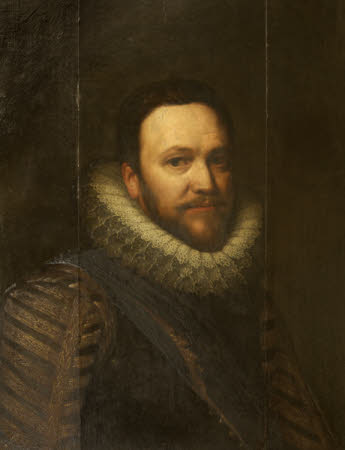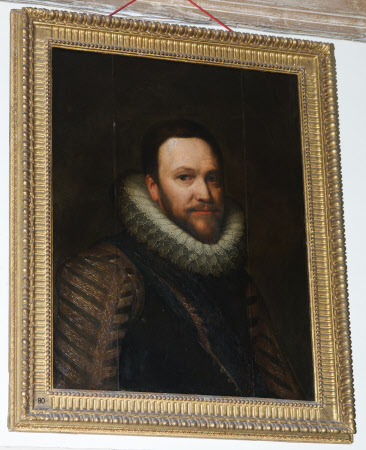Thomas Coventry, 1st Baron Coventry of Aylesborough (1578-1640), Lord Keeper
after Cornelius Johnson (London 1593 - Utrecht 1661)
Category
Art / Oil paintings
Date
1670 - 1699
Materials
oil on panel
Measurements
673 x 521 mm (26 1/2 x 20 1/2 in)
Order this imageCollection
Lacock, Wiltshire
NT 996345
Caption
This is a good-quality, reduced version of a three-quarter length original, showing the sitter in his peer’s robes, now on loan to County Hall, Maidstone. Lord Coventry sat to Johnsom on some five occasions between 1623 and 1639, so there are various versions of this type. There are also copies at other National Trust properties: Antony, Charlecote and Erddig. Lord Coventry was a prominent English lawyer, politician and judge. In 1617 he was made Solicitor-General by James I and knighted, and in 1621 he became Attorney General. On the ascent of Charles I in 1625, he was promoted again, to Lord Keeper. He was created Baron Coventry of Aylesborough in 1628. As a Protestant, it is thought that his appointment served to quell religious friction following the King’s marriage to Henrietta Maria. Johnson became the King’s Painter in 1632, perhaps on the recommendation of Lord Coventry. Fearful of the consequences of the Civil War, he retired to Holland in 1643, finally settling in Utrecht where he died.
Summary
Oil painting on panel. A head-and-shoulders portrait of a man with a neatly trimmed beard and moustache, turned to the right, wearing a black doublet with gold-braided sleeves, a sash, and a white ruff. The identity of the sitter is disputed. There is convincing evidence that this is Sir Horace Vere, painted by Michiel van Mierevelt. Previously thought to be Sir Thomas Coventry, 1st Baron Coventry of Aylesborough (1578-1640), Lord Keeper, after Cornelius Johnson (London 1593 - Utrecht 1661).
Full description
Lord Coventry sat to Janssen on some five occasions between 1623 and 1639, so there are various versions of this type ( cf. Robin Gibson, Catalogue of Portraits in the Collection of the Earl of Clarendon, 1977, no. 54; see also, for Coventry’s iconography in general, David Piper, Catalogue of Seventeenth-Century Portraits in The National Portrait Gallery, Cambridge, 1963, no. 716): the earliest portrait of Coventry, aet. 44, (i.e. of 1622/3), in a black gown, probably as Attorney-General (appointed 1620), and possibly by Jonson, was sold at Christie’s on 1 March 1946 (lot 63) [? acquired by Leggatt Bros.], and with The Weiss Gallery in 1999 (is this that sold at Sotheby’s, 31 March 1999, lot 63, ex Mrs Vincent-Gompertz of Glendon Hall, Kettering (120 x 98 cm.?) ¾ -length, signed and dated by Jonson in 1627, formerly in the collection of Lord Brabourne, and on loan to County Hall, Maidstone, but with The Weiss Gallery, 2002. The face in the present picture appears somewhat more rounded than in that. ¾ length, in his robes as Lord Keeper of the Great Seal (appointed 1625), signed and dated 1631, is in the Clarendon Collection (Gibson, no.54), on loan to the House of Lords: another version, also signed and dated 1631, was, with a pendant of his wife, in the collection of the Frewens of Brickwall, until sold at Sotheby’s, 12 March 1986 (lot 30). ½ length version, signed and dated 1634, at Longleat. signed and dated 1639 (the final year of his life), showing him with grey hair and the Speaker’s mace, was in the Savile Collection at Rufford Abbey until sold at Christie’s on 19 November 1938 (lot 72), and is now in the NPG. . In the collections of houses belonging to the National Trust, there is a version of the Frewen of Brickhill type at Charlecote, and a copy of the head-and-shoulders of this type at Antony. At Erddig there is a somewhat similar variant of this, facing the opposite direction, and with the Keeper’s purse displayed heraldically before his proper left arm and chest, and giving him a much more rounded nose. Son of the judge, Thomas Coventry of Croome d’Abitot, Worcestershire. Early on in his career as a lawyer, he allied himself to Sir Edward Coke, whose support helped his rapid advancement. His allegiance to Coke, however, resulted in the enmity of Lord Bacon, who, in an unsuccessful attempt to stop the appointment of Coventry in 1616 to the recordership of London, told King James, ‘The man upon whom the choice is like to fall, which is Coventry, I hold doubtful for your service; not but that he is well learned and an honest man, but he hath been, as it were, bred by Lord Coke and seasoned in his ways.’ Bacon singularly failed in his attempt to blight Coventry’s career, for in the following year, he was made Solicitor-General by James I and knighted. He was made Attorney General in 1621. On the ascent of Charles I, in 1625, he was promoted again, and appointed Lord Keeper. He was created Baron Coventry of Aylesborough in 1628. As a Protestant, it is thought that his appointment served to quell religious friction following the King’s marriage to Henrietta Maria. He was renowned for his integrity and moderation, and was described by Clarendon as having ‘a clear conception of the whole policy of the government, both of church and state … he knew the temper, disposition and genius of the kingdom most exactly … he had, in the plain way of speaking and delivery, without much ornament of elocution, a strange power of making himself believed.’ As one of the few statesmen who commanded popular respect, his death during the constitutional crisis of 1640, was a considerable misfortune for the King. Jonson became the King’s Painter in 1632, perhaps on the recommendation of Lord Coventry. Fearful of the consequences of the Civil War, he retired to Holland in 1643, finally settling in Utrecht where he died.
Provenance
Given by Matilda Theresa Talbot (formerly Gilchrist-Clark) (1871 – 1958), who gave the Abbey, the village of Lacock and the rest of the estate to the National Trust in 1944, along with 96 of the family portraits and other pictures, in 1948
Credit line
Lacock Abbey, The Talbot Collection (National Trust)
Makers and roles
after Cornelius Johnson (London 1593 - Utrecht 1661), artist previously catalogued as attributed to Michiel Jansz. van Miereveldt (Delft 1567 – Delft 1641), artist

